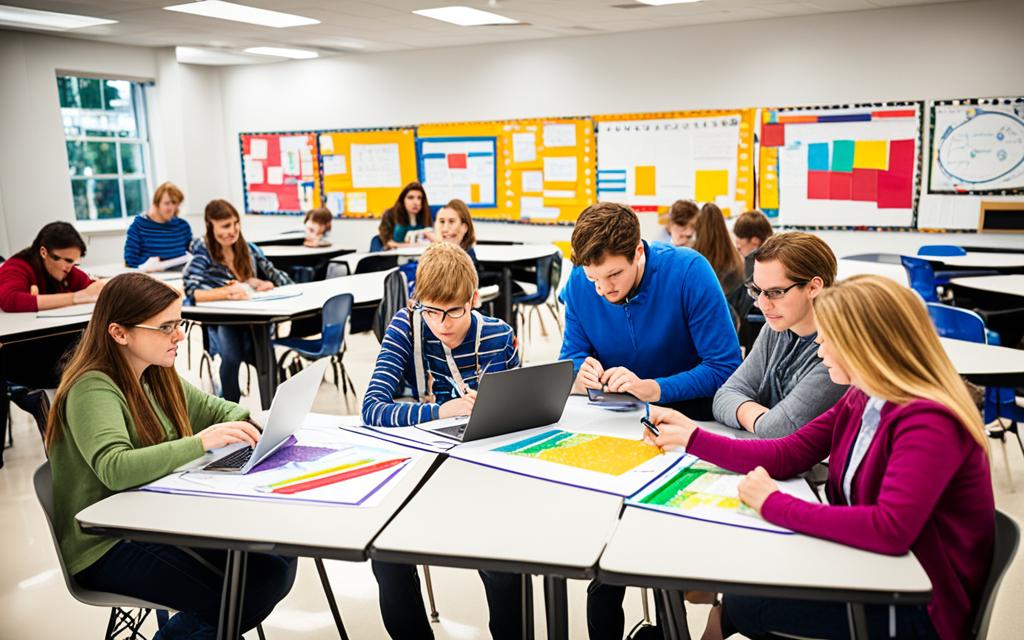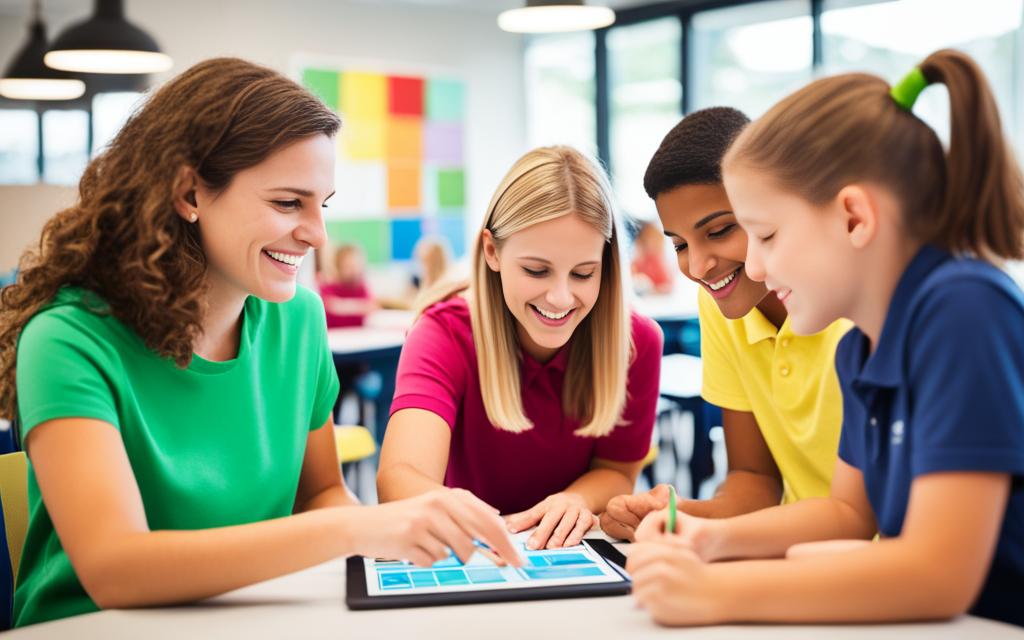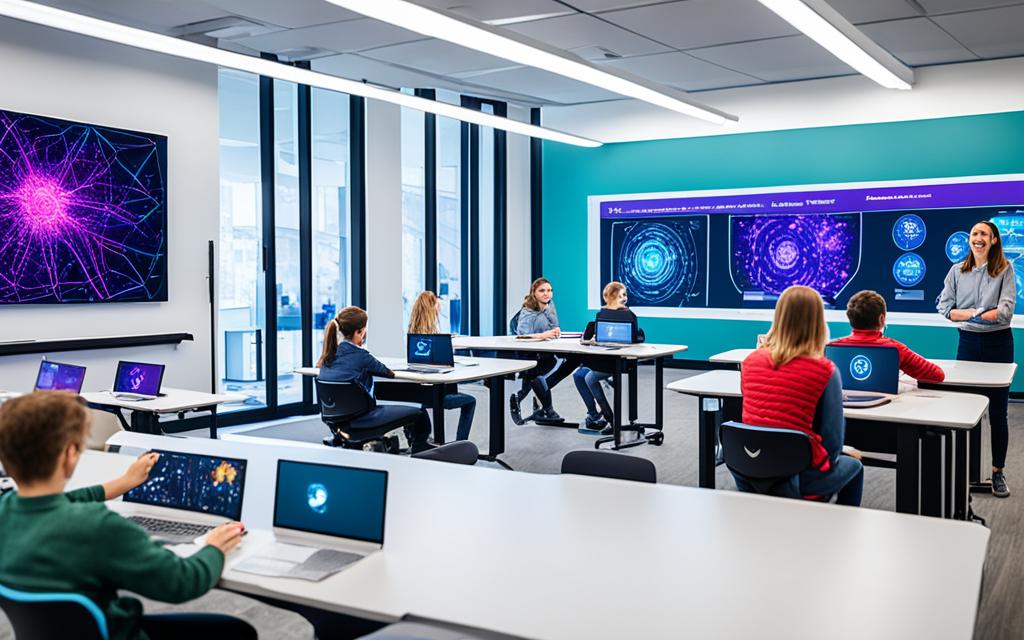Technological advancements are making big changes in how we learn, going beyond just classrooms.1 The recent jump in education tech was because of a post-pandemic world. Adding tech to how we learn became crucial.1 The pandemic showed us how vital it is to have creative ways to teach, changing the way students and teachers work together and learn.1 This shift has transformed how we experience education, bringing fresh ways to keep learning throughout life with tech.1
Key Takeaways
- Technological advancements are driving significant changes in the educational landscape.
- The pandemic has accelerated the integration of technology into education, making it essential for adapting to the new landscape.
- Innovative teaching methods and tools, such as virtual classrooms and online collaboration platforms, have transformed the way students and educators interact and learn.
- Technology is extending learning beyond traditional classroom boundaries, enabling global collaboration and the integration of advanced educational technologies.
- The evolution of educational technology has brought a wide range of innovative devices and digital learning tools into the classroom.
The Transformative Power of Technology in Education
The pandemic has hit the fast-forward button on tech in education, turning it into a must-have.2 It’s brought in new ways to teach, like online classes and video chats. These tools are changing how students and teachers get together and share knowledge.3 Now, learning goes way past the four walls. It lets students from around the world work together. They can also enjoy learning that’s made just for them. Plus, cool gadgets like interactive whiteboards and 3D printers make lessons more exciting.
Adapting to the Post-Pandemic Landscape
The pandemic pushed us to use tech in education like never before.3 Teachers had to quickly find new ways to teach. They turned to digital tools to keep education going and to keep students interested. This big change is leading us to a future where tech plays a big part in how we learn.
The Importance of Innovative Teaching Methods and Tools
3 Lessons in online rooms, video calls, and working together online have become key. They’ve made it possible to keep learning during the pandemic. But they’ve also shown us new ways to learn together. And they’ve made it easier to use amazing techs like virtual reality (VR) and augmented reality (AR).
2 When teachers use VR in class, students get way more into their lessons. A study found that it makes learning 65% more interesting for them.
Extending Learning Beyond Traditional Classrooms
Tech helps teachers spread knowledge outside the classroom.2 Lots more students have joined online classes in the past five years. That shows education is reaching more people all over the world.3 Thanks to online tools, students and teachers can come together from far away. It helps them learn from each other’s different views. This makes us all understand the world better.
Project-Based Learning: Fostering Independent Thinking
Project-based learning (PBL) is a strong method that encourages thinking on your own and solving problems.4 Students work on real-world issues and find answers, improving their creativity, critical thinking, and teamwork skills.4
This method helps students get ready for their future jobs. It gives them the needed abilities for a world that always changes.
Real-World Problem-Solving Skills
Research shows that PBL students do better than others on tests.5 They learn to solve real-life problems, gaining skills that are wanted in today’s jobs.6
Through PBL, students get better at critical thinking and using what they know to solve hard tasks.4
Promoting Creativity and Collaboration
PBL supports different learning ways. It lets students be creative and feel better about their skills.4 This approach sparks creativity and an interest in learning that lasts outside of school.
It has been found that students in New Tech Network schools are more into their learning. They also get better at working together, taking charge, thinking critically, and communicating well, which are all important at work.5

Technology is now very important in learning, especially after the pandemic.6 Jonathan Lockwood, from Boxlight, talked about this on the “UnBox Innovation” show. He explained how PBL helps students think and solve problems on their own.
PBL gets students ready for their jobs by giving them important skills for a market that always changes.
Integrating Advanced Educational Technology
Bringing in technologies like interactive whiteboards and 3D printers is changing how we learn.7 These tools help teachers make lessons more interesting and fun. They also let students work together more.
Students get to see and use technology they might use in the future. So, it’s not just about learning but also getting ready for their jobs. This way, classrooms become more like places of discovery and teamwork.
Interactive Whiteboards and 3D Printers
Interactive whiteboards and 3D printers make learning new things truly exciting. They add videos, photos, and more to lessons. Students can work on projects together in real time. This means they learn by doing, which is the best way.
Turning ideas into real things is a big deal. It makes learning feel real and connected to the world outside. By using these tools, teachers give life to what they teach. They help students become more involved and get ready for the cool jobs of tomorrow.
Enhancing Classroom Engagement
New technologies make learning much more interesting.7 Teachers can make lessons that are not just words but lively and colorful. Students can join in more because they see and touch ideas.
These high-tech tools make learning like an adventure. They push kids to be more curious and excited about their studies. Plus, they learn how to work in teams and use new tools, which are important for the jobs waiting for them.
Global Collaboration through Technology
Technology connects students and teachers anywhere in the world8. Online classes and platforms let people share ideas and learn from each other’s cultures. This makes everyone understand and value different viewpoints more.8 It also teaches students skills they need today, like talking to people from other cultures and being aware of different customs. This helps them fit into a world that’s always more connected.
Connecting Students and Educators Worldwide
A podcast talked about how using technology helps students and teachers from different parts of the world meet.6 By sharing through online platforms, knowledge travels far. It also makes people more aware of different cultures and ways of life.8
Fostering Cultural Awareness and Understanding
Global projects using technology have really helped students understand other cultures better8. These projects let students from different places learn about each other. They help students see the world as a place where many cultures live together.8 Teachers use these online tools to help students talk about their differences in a good way. This makes students more open-minded and respectful of others.

Innovations in Education Technology
Educational technology has really changed how we learn, bringing new tools into the classroom.9 We now use things like interactive whiteboards, educational apps, and online resources. These make learning more fun and easy.9
Interactive Devices and Digital Learning Tools
New tools like interactive whiteboards and 3D printers are changing schools.9 Teachers can now make lessons more interesting and work together with students. They also get to try out technology they’ll use in the future.
Educational Apps and Online Resources
There are so many new apps and sites for learning.10 They give students lots of things to learn about and the freedom to learn in their own time.10
Developing Digital Literacy Skills
Using these new technologies is teaching us important digital skills.9 These skills help us use technology better and get ready for future jobs.9
Personalized Learning through Adaptive Technologies
Now, with the help of AI, education is changing for the better. It’s offering personalized learning to every student.11 These technologies keep an eye on how well a student is doing. Then, they change what and how they learn to fit the student perfectly. This way, each student gets exactly what they need to learn best.12 Research proves this approach makes students more interested in learning. And, it helps them do better in their studies.12
Artificial Intelligence in Education
AI-powered tools give teachers special insights. These insights help teachers cater lessons to every student’s unique learning style.12 They use a mix of teaching tools, management systems, and more to make learning special for each student.12
Tailoring Lessons to Individual Student Needs
Thanks to AI, lessons can be designed for each student’s special way of learning.11 This not only makes learning fun but also speeds up the learning process.11
Real-Time Progress Tracking and Interventions
AI helps teachers see how students are doing all the time. This means they can help students immediately if they’re having trouble.12 Tests change based on how a student answers them. This makes sure the test is just right for each student.12 Such close tracking helps teachers fill any learning gaps. And it makes teaching methods better, so everyone can learn well.

Collaborative Learning in Hybrid and Blended Models
Hybrid and blended learning have brought in a new way for students to learn together. This is thanks to online tools that let students work as a team, no matter where they are.
These tools help students to learn and work well together. They also get used to working in digital spaces. This way, they prepare for jobs where team skills and good communication are key.
Online Collaboration Tools and Platforms
Now, students can work together in more ways than before.13They use video calls, shared documents, and tools for brainstorming together. This makes teamwork and finding solutions easier and more fun.
Working with these tools helps students learn to solve problems and express their ideas.13It also lets them meet people from around the world. So, they understand different cultures better, getting ready for a job that’s not just local.
Building Teamwork and Communication Skills
Using these online tools, students improve their teamwork and communication.14They do this through talking with each other, working on projects, and solving problems together. These activities teach them how to work well with different kinds of people.
Employers really want people who can work in a team and communicate clearly.14Teaching these skills helps students succeed in school and later on, at work. Plus, it makes them ready for jobs that will need them to adapt to new tech.
Generative AI in the Classroom
Generative AI has changed how education works in a big way, giving teachers new tools and getting students ready for tomorrow’s jobs.15 These AI tools, like ChatGPT, make teachers’ jobs easier by handling boring tasks. This gives teachers more time to focus on each student.
Students learn important skills by using these advanced AI tools. They get ready for a future where AI is very important.15 Skills like critical thinking and understanding technology are key for doing well in future jobs thanks to these tools.
Streamlining Educator Workflows
AI tools help teachers a lot by doing things like grading papers and making lesson plans for them.16 Almost every teacher uses ChatGPT to help with their work in some way, with many using it to write lessons.16 This tech makes it easier for teachers to create great learning opportunities for students and give them the help they need.
Preparing Students for the Future of Work
Work is changing, and AI is a big part of that change. It’s very important for schools to teach students about AI so they’re ready for these new jobs.17 Schools should add AI to what they teach in and out of class to make their programs better and get students ready for an AI-focused future.
Working with AI tools also teaches students about things like being creative and thinking about ethical issues. These skills are very important for their future success.17
But, teachers and schools need more help in how to use AI in the right way. Many schools don’t have clear rules about AI. So, teachers should keep learning about how to use AI in the best way.1617 Programs that look at ethics in using AI, like the one at UNC Charlotte, are very important. They help make sure students understand the right way to use AI.17

15 Generative AI can make learning more interesting and help students find info quickly. It helps all students, not just some, by encouraging creativity and making research easier.15 But, knowing how to work with AI is just as important as using it. AI tools can’t replace human creativity and judgment.15 So, it’s vital that we keep learning about AI to use it well in the classroom.15
Equity and Accessibility in Educational Technology
Ensuring equity and accessibility in technology for education is vital. It shapes our future educational system. To achieve fairness in education, schools and districts must create systems. These systems ensure every student has an equal chance to succeed.18 Making technology accessible is more than just providing access. It means making sure every student can benefit from it.18
Bridging the Digital Divide
The COVID-19 pandemic showed us the big gaps in tech access. Some students and families lacked devices and fast internet. They also didn’t have what they needed to do homework and learn tech skills.19 Today, being able to connect to the internet is seen as a basic need. It affects how well students and their families can live their lives.19 The challenges to get online vary by location. In rural areas, there might not be a good internet service. In cities, it’s often about how much internet service costs.19
Democratizing Access to Quality Education
Teachers, community groups, and leaders are pushing for awareness and solutions. They want to close the digital gap and give everyone a fair shot at good education. Making technology with the user in mind can save money and lead to better tech choices.18 When asking for tech proposals, including what makes it easier for everyone to use is important. It helps meet the needs of a range of students.18 Giving more budget to programs that help a variety of students is key.18
It’s also important to ask tech companies to make their products better and more useful for all students. Checking different tech systems to see where they fall short is also crucial. Making sure different tech tools can work together and are easy for students to use is a big step.18 Some things to ask about include language help, tools for special needs, and more. Using teaching designs that can be adjusted to different learning styles will help make learning easier and fair for all.18
Conclusion
Innovative education technology is changing how we learn. It brings new ways to learn and face new challenges. Personalized learning, working together, and advanced AI are making big changes.20
Looking ahead, tech in education is ultra-important. It will get students ready for jobs and make them skilled lifelong learners. These learners will be ready for the future like never before.21
The pandemic speeded up how we use tech in learning. Now, it’s key for taking on new learning settings. Virtual classrooms and video calls are changing how teachers teach and how students study.20
Tech is breaking classroom walls, letting us learn from anywhere. It encourages global teamwork, custom learning, and using cool gadgets like 3D printers. This makes learning more fun and effective.21
FAQ
What are the key innovations driving changes in the educational landscape?
How has the pandemic accelerated the integration of technology in education?
What is the role of project-based learning (PBL) in fostering independent thinking and problem-solving skills?
How are advanced educational technologies transforming traditional classrooms?
How does global collaboration through technology empower students?
What are the key innovations in educational technology?
How are adaptive learning technologies revolutionizing the way students learn?
What is the role of collaborative learning in hybrid and blended models?
How are generative AI tools transforming the classroom experience?
What are the challenges in ensuring equity and accessibility in educational technology?
Source Links
- https://marketscale.com/industries/education-technology/educational-technology-innovations-beyond-classroom-walls/
- https://drbstomar.com/technovations-unleashing-the-transformative-power-of-technology-in-education/
- https://www.linkedin.com/pulse/transformative-power-edtech-revolutionizing-education-manojit-dey
- https://www.methodschools.org/blog/project-based-learning-fostering-creativity-and-innovation-in-students
- https://newtechnetwork.org/resources/what-is-pbl
- https://marketscale.com/industries/education-technology/educational-technology-innovations-beyond-classroom-walls
- https://wolfvision.com/en/news/exploring-edtech-the-role-of-education-technology-in-enhancing-learning-experiences
- https://teachers.tech/empowering-collaboration-with-innovative-classroom-technology-tools
- https://www.theamegroup.com/top-6-technology-innovations-education/
- https://meetaverse.com/blog/top-innovations-in-education/
- https://knowledgeworks.org/resources/personalized-learning-role-technology/
- https://www.ucats.org/innovations-in-educational-technology-and-classroom-integration.html
- https://edtechmagazine.com/k12/article/2021/08/hybrid-blended-learning-using-tech-improve-students-experience
- https://www.gyrus.com/hybrid-vs-blended-learning
- https://teaching.cornell.edu/generative-artificial-intelligence
- https://edtechmagazine.com/k12/article/2024/04/examining-generative-ai-tech-enabler
- https://professional.charlotte.edu/spotlights/unc-charlotte-offers-professional-development-certificate-generative-ai-education
- https://www.cosn.org/defining-equity-in-terms-of-technology-accessibility/
- https://www.setda.org/2021/06/23/equity-of-access/
- https://www.thepolicycircle.org/brief/innovation/
- https://www.educause.edu/ecar/research-publications/ecar-study-of-undergraduate-students-and-information-technology/2018/conclusion-and-recommendations
